Quilts do more than keep you warm—they define the look, feel, and balance of a bedroom. The right size ensures perfect drape, seamless layering, and comfort that feels custom-made.
Yet, quilt sizing isn’t always straightforward; measurements can vary between manufacturers, bed types, and even regional standards.
This guide cuts through the confusion with exact dimensions, expert tips, and practical charts so you’ll never second-guess which quilt fits best.
From twin to oversized king, discover how to choose a quilt that looks tailored, feels luxurious, and complements your sleep space flawlessly.
Complete Quilt Sizes Chart
| Category / Name | Typical Size (in) | Typical Size (cm) | Typical use / note |
|---|---|---|---|
| Micro / Doll / Lovey | 12 × 12 | 30 × 30 | Doll blanket, security lovey |
| Preemie | 18 × 24 | 46 × 61 | Hospital/preemie crib use |
| Bassinet / Cradle | 14 × 28 → 18 × 36 | 36 × 71 → 46 × 91 | Small bassinets/cradles |
| Security / Comforter (small) | 14 × 18 → 20 × 24 | 36 × 46 → 51 × 61 | Small comfort patch |
| Car seat | 20 × 24 | 51 × 61 | Infant car seat cover |
| Stroller / Pram | 22 × 30 → 30 × 36 | 56 × 76 → 76 × 91 | Stroller or stroller-to-go size |
| Receiving / Swaddle | 30 × 30 → 40 × 40 | 76 × 76 → 102 × 102 | Swaddle / receiving blanket |
| Newborn / Small Baby quilt | 30 × 40 | 76 × 102 | Newborn photos, small quilt |
| Baby quilt (standard) | 36 × 52 | 91 × 132 | Fits standard crib mattress area (nap quilts) |
| Crib quilt (larger) | 36 × 54 → 45 × 60 | 91 × 137 → 114 × 152 | Alternative crib sizes / toddler nap quilt |
| Toddler quilt | 40 × 60 | 102 × 152 | Toddler bed / nap mat |
| Lapghan / Wheelchair lap quilt | 36 × 48 → 40 × 60 | 91 × 122 → 102 × 152 | Lap use, wheelchair coverage. |
| Throw (afghan) | 50 × 60 → 54 × 72 | 127 × 152 → 137 × 183 | Couch/sofa throw |
| Small throw / decorative | 40 × 50 | 102 × 127 | Accent throw |
| Twin / Single quilt | 68 × 86 → 70 × 90 | 173 × 218 → 178 × 229 | Fits twin mattress (39×75–80″); common quilt sizes vary. |
| Twin XL quilt | 68 × 90 → 72 × 96 | 173 × 229 → 183 × 244 | For Twin XL beds (39×80–80+), dorms |
| Full / Double quilt | 78 × 86 → 82 × 90 | 198 × 218 → 208 × 229 | Fits full/double mattresses (54×75) |
| Full XL (less common) | 82 × 96 | 208 × 244 | For longer full mattresses |
| Queen quilt | 86 × 92 → 90 × 96 | 218 × 234 → 229 × 244 | Common quilting pattern sizes; gives generous drop. |
| Olympic / Square Queen | 90 × 90 | 229 × 229 | Square queen-style quilts |
| King quilt | 104 × 92 → 110 × 96 | 264 × 234 → 279 × 244 | Standard US king coverage (76×80 mattress). |
| California King quilt | 96 × 104 | 244 × 264 | For CA King mattress (72×84) |
| Oversized Queen / King (hotel / generous drop) | 110 × 110 → 120 × 120 | 279 × 279 → 305 × 305 | Extra drape for layered bedding |
| Euro / Square decorative (bed topper, Euro) | 26 × 26 → 30 × 30 | 66 × 66 → 76 × 76 | Euro pillow/sham squares (not bed quilts) |
| Wall hanging / Mini-quilt | 12 × 20 → 24 × 36 | 30 × 51 → 61 × 91 | Decorative wall quilts |
| Table runner / mantle mini-quilt | 12 × 36 → 18 × 60 | 30 × 91 → 46 × 152 | Decorative quilting pieces |
| Boat / RV narrow / custom | custom widths 60–70 by shorter lengths | custom | Many RVs and boats need bespoke measurements (measure mattress). |
| International / Regional variants (UK/AU) | King Single (70 × 95 cm ≈ 28×37 in), AU Double/King sizes vary | see regional charts | Regional names differ — always match to local mattress dims. |
Mattress vs. Quilt Dimensions
Both are not same, and here is why:
Why Quilts Are Larger Than Mattresses
Mattress measurements represent only the sleeping surface—quilts must extend beyond these dimensions to provide proper coverage. Standard quilts include overhang (drop) on three sides: both long edges and the foot of the bed. The headboard area typically requires less coverage since pillows rest there.
Standard Overhang Measurements
Minimal Coverage: 8-10″ drop on each side and foot
- Creates neat, tailored appearance
- Suitable for platform beds without box springs
- Exposes decorative bed frames
- Easier to tuck hospital corners
Standard Coverage: 12-15″ drop on each side and foot
- Most popular choice for traditional beds
- Covers box spring completely
- Provides comfortable warmth without touching floor
- Balances fabric usage with aesthetics
Generous Coverage: 18-22″ drop reaching near or to floor
- Eliminates need for dust ruffles or bed skirts
- Creates luxurious, enveloping feel
- Best for beds with thick mattresses or high box springs
- Requires significantly more fabric and quilting
Pillow Tuck Considerations
Adding 10-15″ to the length accommodates pillow tuck—folding the quilt over pillows at the headboard. This traditional styling protects pillows and creates polished presentation. Modern quilters sometimes skip pillow tuck for sleeker, contemporary looks.
Detailed Breakdown of Each Quilt Size
We have covered lots of quilt sizes on the above chart. Below we have listed some of the major quilts that you should look at before dive into sewing:
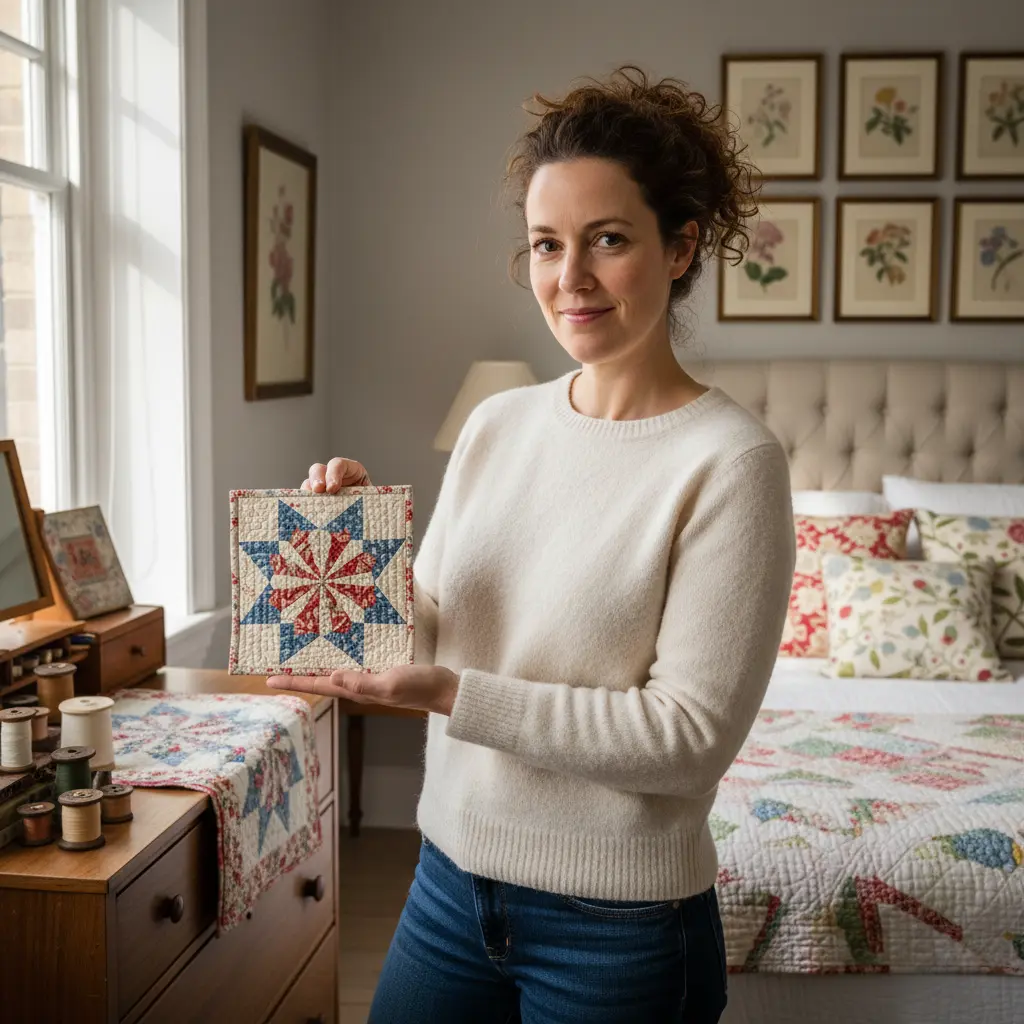
Mini Quilts (12″ x 12″ to 24″ x 24″)
Purpose and Uses: Mini quilts serve as artistic expressions rather than functional bedding. Perfect for testing new techniques, creating seasonal décor, or showcasing intricate blocks that would become overwhelming in larger quilts.
Construction Benefits:
- Complete projects in single afternoons
- Minimal fabric investment
- Ideal for experimenting with challenging blocks
- Perfect for gift exchanges and swaps
- Excellent teaching tools for beginners
Display Options: Frame as wall art, arrange in gallery walls, use as mug rugs, incorporate into larger projects as appliqué elements, or create advent calendars with 24 mini quilts.
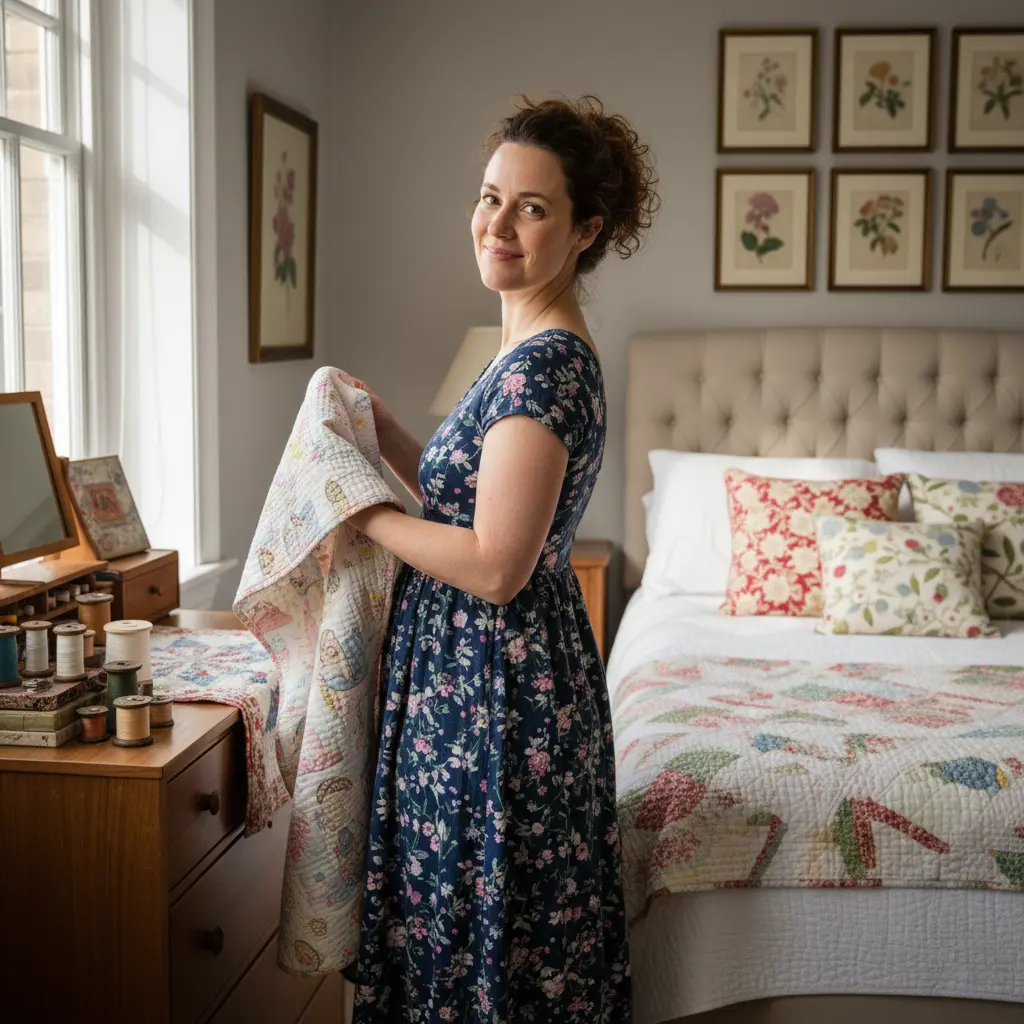
Baby Quilts (30″ x 40″ approximate)
Size Flexibility: Baby quilt dimensions vary widely because functionality differs. Small 30″ x 30″ quilts work for stroller draping, while larger 40″ x 50″ versions suit floor play and crib decoration.
Safety Considerations: Never place quilts in cribs with infants under 12 months due to suffocation risks. Use these quilts for supervised tummy time, nursing covers, stroller warmth, or decorative wall hangings until baby reaches appropriate age.
Sentimental Value: Baby quilts often become treasured keepsakes. Choose quality fabrics and construction techniques that withstand decades of love and washing. Many adults still cherish baby quilts from their infancy.
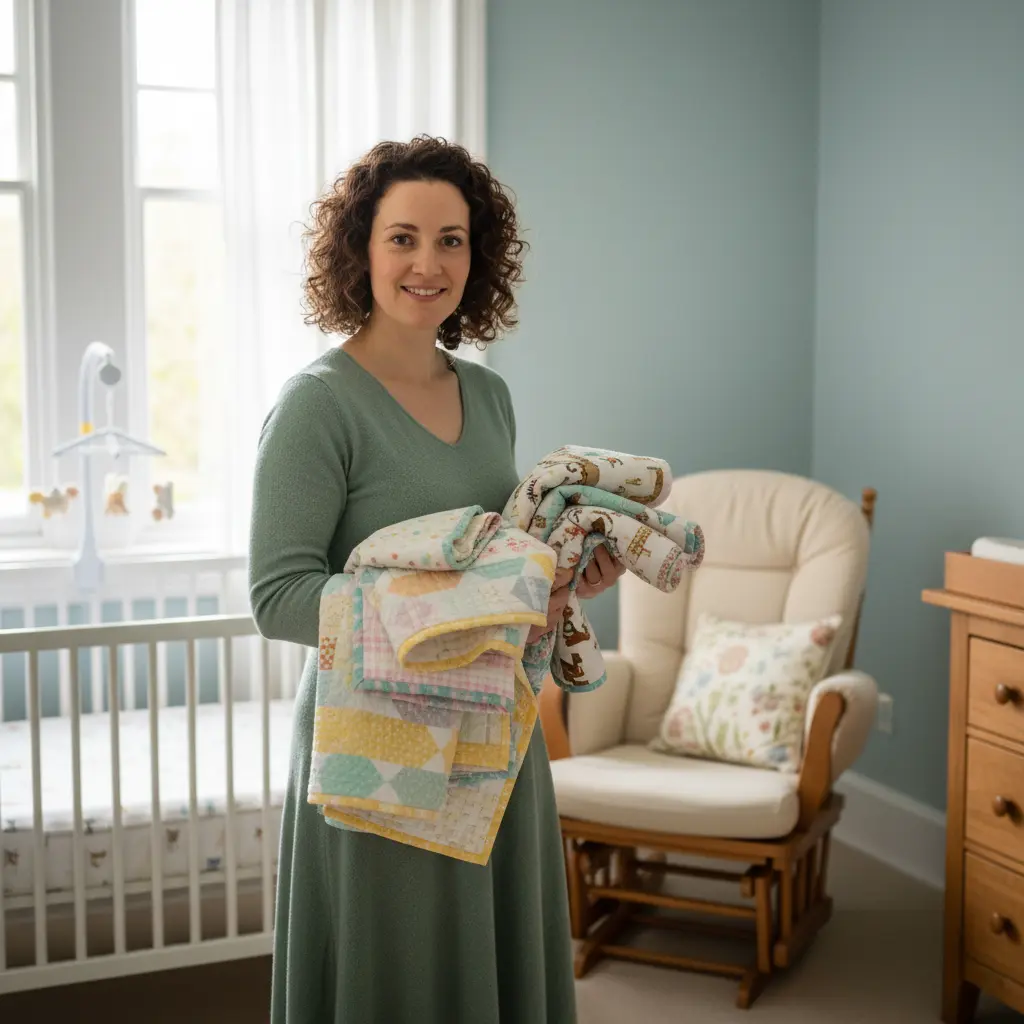
Crib Quilts (36″ x 52″)
Standard Crib Mattress: Most crib mattresses measure 28″ x 52″, making 36″ x 52″ quilts provide modest overhang while fitting toddler beds perfectly as children grow.
Versatility Beyond Cribs: These dimensions work beautifully for toddler beds, as generous lap quilts, wall hangings in nurseries, or car seat covers (never use while driving—safety hazard).
Construction Considerations: Crib quilts complete quickly, typically requiring only 1.5-2 yards of main fabric. Perfect for practicing new techniques without committing to massive projects.
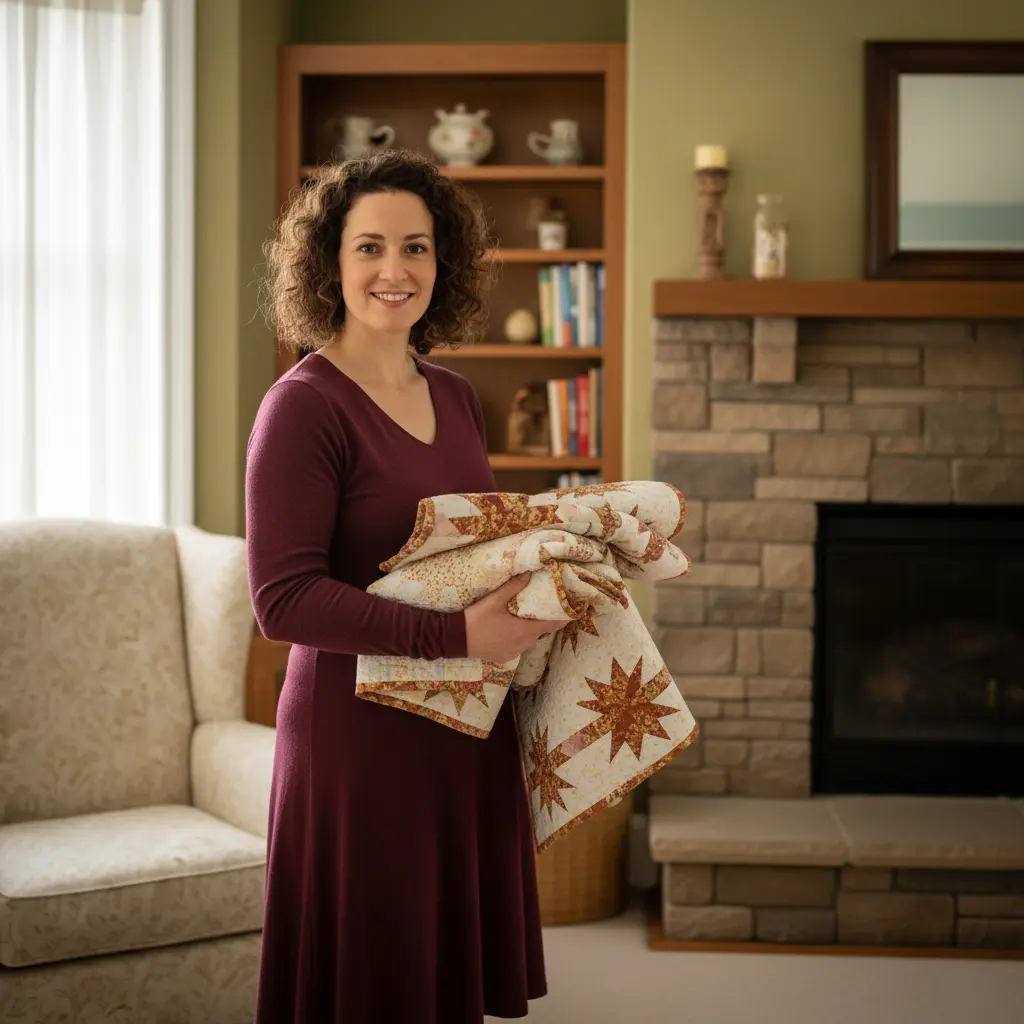
Throw/Lap Quilts (50″ x 65″)
Universal Appeal: Throw quilts reign as most popular non-bed quilt size. They suit wheelchair users, couch snugglers, picnic attendees, and anyone wanting portable warmth.
Sizing Variables: Consider recipient height. Standard 50″ x 65″ works for average adults, but tall individuals appreciate 60″ x 70″ versions. Wide throws accommodate two people snuggling together.
Quick Construction: Throw quilts balance satisfying completion times with impressive results. Most quilters finish throw-sized projects within weeks, making them excellent gifts for weddings, housewarmings, or holidays.

Twin Quilts (70″ x 90″)
Bed Coverage: Twin mattresses (39″ x 75″) receive generous coverage from 70″ x 90″ quilts, with approximately 15″ overhang on sides and foot.
Target Demographics: Perfect for children’s rooms, guest bedrooms, daybeds, and anyone transitioning from crib to “big kid” bed. These quilts carry emotional significance as childhood companions.
Construction Complexity: Twin quilts represent significant step up from throws in time and fabric requirements, typically needing 3-4 yards of main fabric depending on pattern complexity.
Twin XL Quilts (70″ x 95″)
Dorm Room Essential: College dorm beds almost universally use Twin XL mattresses (39″ x 80″). Standard twin quilts leave feet exposed—unwelcome surprise for college freshmen!
Five-Inch Difference: That extra 5″ length distinguishes Twin XL from standard twins. When gifting quilts for college students, always verify mattress dimensions to avoid disappointment.
Growing Teens: Tall teenagers appreciate Twin XL even in home bedrooms, preventing midnight battles with too-short blankets.
Double/Full Quilts (85″ x 108″)
Mattress Coverage: Full mattresses (54″ x 75″) accommodate these quilts with approximately 15″ drop on sides and generous foot coverage.
Middle Ground: Full-size quilts bridge gap between twin and queen, perfect for guest rooms, young adults’ first apartments, or couples preferring cozier sleeping arrangements.
Fabric Requirements: Expect to use 5-7 yards of main fabric depending on design complexity. These quilts require commitment but remain manageable for intermediate quilters.
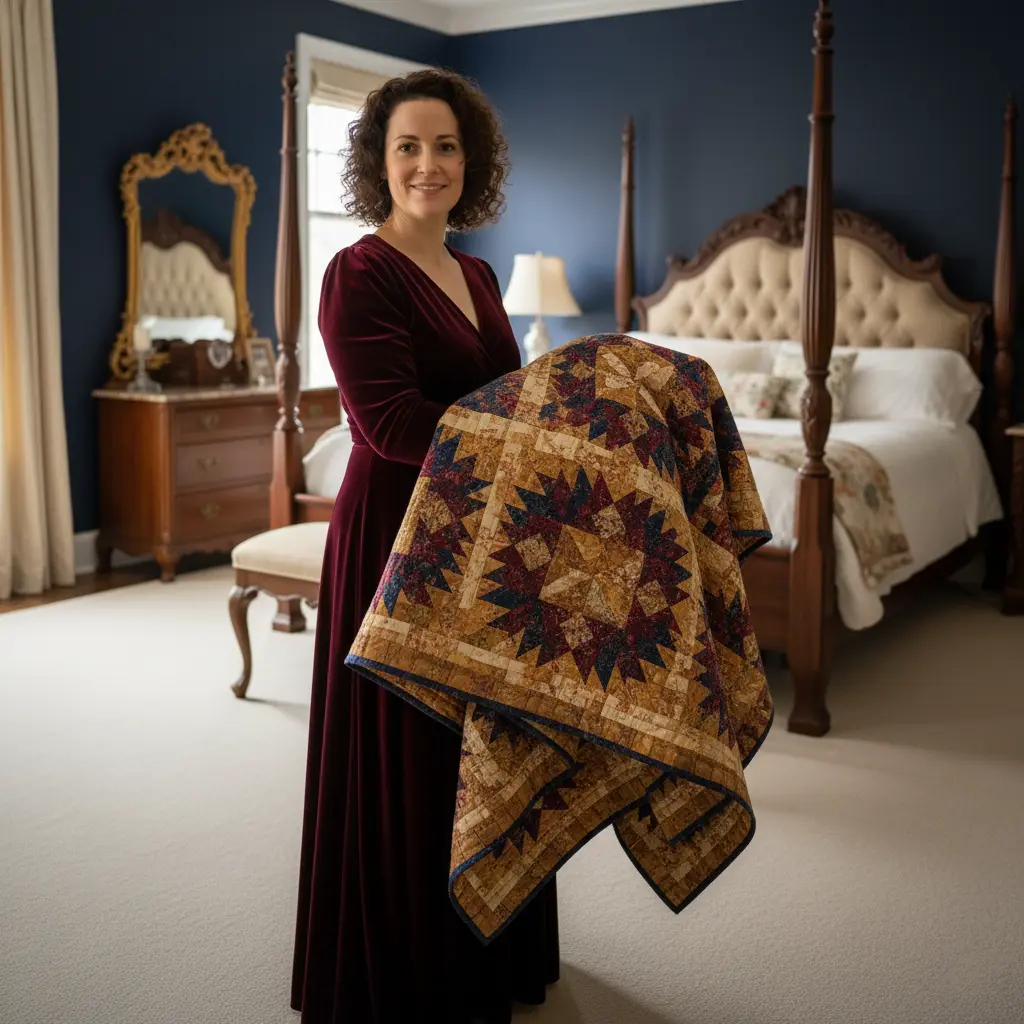
Queen Quilts (90″ x 108″)
Most Popular Bed Size: Queen mattresses (60″ x 80″) dominate modern bedrooms, making queen quilts highly sought-after for both beds and large throw quilts.
Generous Proportions: These dimensions create luxurious coverage with 15″ overhang on sides and substantial foot drop. Many quilters prefer queen quilts even for full-size beds, enjoying extra snuggling room.
Construction Investment: Queen quilts demand significant time and fabric investment—typically 7-9 yards depending on pattern. Plan for several months of work on complex designs.
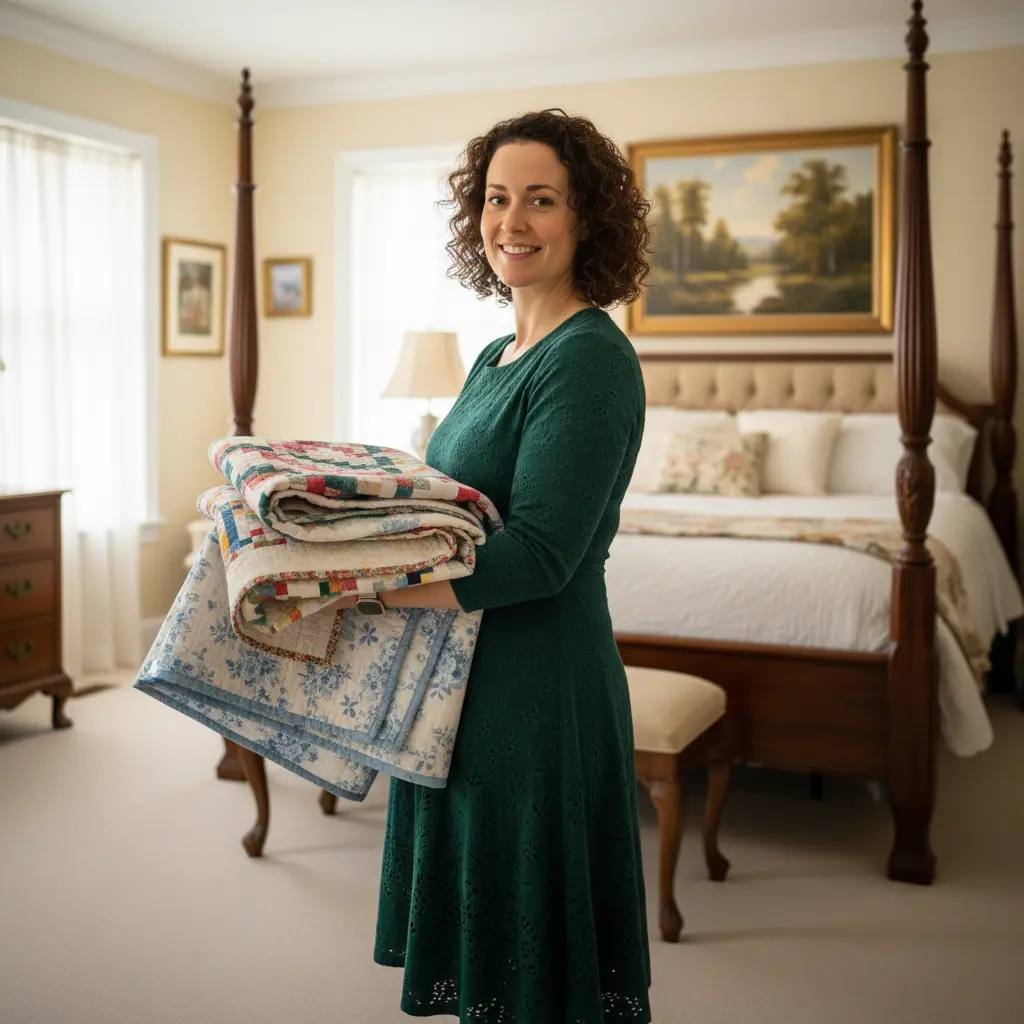
King Quilts (110″ x 108″)
Impressive Scope: King mattresses (76″ x 80″) receive regal treatment from these expansive quilts. With nearly 17″ overhang on each side, king quilts make dramatic statements.
Machine Quilting Challenges: Wrestling king-sized quilts through domestic sewing machines tests patience and space. Many quilters send king projects to longarm quilters for professional finishing.
Heirloom Status: The investment required for king quilts—10-12 yards of fabric, hundreds of hours—naturally elevates them to heirloom status. These quilts often commemorate weddings or anniversaries.
California King Quilts (106″ x 112″)
Unique Dimensions: California king mattresses (72″ x 84″) run narrower but longer than standard kings. This distinction matters when calculating overhang.
West Coast Popularity: California kings predominate on the West Coast and in households with very tall individuals who need extra length.
Pattern Adjustments: Most patterns specify standard king dimensions. Converting to California king requires mathematical adjustments—typically adding length while reducing width slightly.
Batting and Backing Requirements
It’s one of the most important steps to keep in mind while quilting –
Calculating Batting Size
Self-Quilting at Home: Add 2-4″ to quilt dimensions on all sides (4-8″ total width and length). This provides adequate handling room during quilting without wasteful excess.
Longarm Quilting Services: Professional longarm quilters typically require 4-6″ overhang on all sides (8-12″ total). Always confirm specific requirements with your quilter before cutting batting.
Pre-Cut Batting Sizes: Manufacturers offer standard pre-cut batting packages matching common quilt sizes. These convenient options sometimes cut close on overhang—verify dimensions before purchasing.
Backing Fabric Calculations
Width Considerations: Standard quilting cotton measures 42-44″ wide. Quilts wider than approximately 38″ (accounting for seam allowances) require pieced backings using multiple widths.
Horizontal vs. Vertical Seams:
- Vertical seams: Run parallel to quilt length, typically requiring 2-3 widths
- Horizontal seams: Run perpendicular to length, changing fabric requirements
- Creative piecing: Incorporate contrasting fabrics or leftover blocks
Yardage Formula: For quilts requiring pieced backing, multiply quilt width by 2.5 (for two-width backing) or 3.5 (for three-width backing), then convert to yards by dividing by 36.
How to choose the the Right Size for Your Project
Modern mattresses range from 8″ traditional models to 18″ pillow-tops. Deeper mattresses require more overhang to reach similar drop points.
Measure specific beds rather than relying entirely on “standard” sizes. Mattress dimensions vary by manufacturer, and older mattresses may differ from contemporary standards.
Some prefer minimal overhang showing bed frames; others want quilts reaching floors. Factor in individual taste when planning dimensions.
Project Timeline Considerations
Quick Gifts: Baby quilts and throws complete quickly—weeks to months depending on complexity and available sewing time.
Moderate Commitment: Twin through full-size quilts require moderate investment—typically several months of regular work.
Long-Term Projects: Queen and king quilts represent serious commitments potentially spanning 6-12 months. Break large projects into manageable phases to maintain motivation.
Fabric Budget Planning
Cost Scaling: Fabric requirements scale exponentially with size increases. King quilts cost 3-4 times more than throws simply in materials before considering time investment.
Precut Efficiency: Using precuts (charm packs, layer cakes, jelly rolls) for smaller quilts maximizes fabric use while providing curated color coordination.
Historical Context of Quilt Sizes
Let’s look at 1700s where quilting was a bit of mystery –
Evolution of Patchwork Quilting
Patchwork quilts—tops composed of separate blocks sewn together—gained popularity in America between 1750-1850 as textile mills made fabric affordable and accessible. Previously, wholecloth quilts dominated due to fabric scarcity.
Economic Factors: Early patchwork utilized fabric scraps, making necessary use of precious materials. As prosperity increased, complex geometric patterns emerged showcasing fabric abundance rather than mere thrift.
Cultural Significance: Patchwork quilts became distinctly American expression despite European origins. The booming U.S. quilt economy of the 19th century created unique design language still influencing modern quilters.
Depression Era Quilting (1930s)
Surprisingly vibrant quilts emerged during the Great Depression. Small chintzy patterns and delicate florals in pastels created cheerful antidotes to dark times. These quilts featured solid background fabrics in creams, yellows, pinks, and light blues.
Medallion Quilts
Late 18th-century immigrants brought medallion-style techniques—central blocks surrounded by multiple borders. While European quilters continued this tradition, American quilters largely moved toward block-based designs. Contemporary quilters have revived medallion quilts, often incorporating modern asymmetry.
Gee’s Bend Legacy
The isolated African American community of Gee’s Bend, Alabama, produced extraordinary quilts combining traditional blocks with innovative improvisation. Descendants of enslaved people who worked cotton plantations beginning in 1816, these quilters developed unique aesthetic now celebrated in museums worldwide.
Gee’s Bend quilts demonstrate how traditional techniques transform into modern design through creative freedom. Their bold colors, asymmetric composition, and improvisational piecing influence contemporary quilters seeking artistic expression.
Common Quilting Questions
Do quilt sizes follow strict standards?
No absolute standards exist—only widely accepted guidelines. Personal preference, mattress thickness, bed frame height, and intended use all influence appropriate quilt dimensions.
Can I make quilts larger or smaller than standard sizes?
Absolutely! Standards provide starting points, not rigid requirements. Adjust dimensions to suit specific needs, preferences, or creative visions.
How much fabric shrinkage should I expect?
Cotton quilts typically shrink 3-5% after first washing, potentially losing 2-4″ on larger quilts. Prewashing fabric prevents post-completion shrinkage, though many quilters prefer initial crinkled texture from quilting unwashed fabrics.
Should I prewash quilt fabrics?
Arguments for prewashing:
- Prevents color bleeding
- Removes manufacturing chemicals
- Pre-shrinks fabric preventing post-quilt distortion
- Softens stiff fabrics
Arguments against prewashing:
- Fabric stiffness improves piecing accuracy
- Modern quality fabrics rarely bleed problematically
- Crinkled texture after first wash creates vintage appeal
- Time savings
What’s the difference between quilt sizes and comforter sizes?
Comforters typically run larger than quilts, often reaching floors entirely. Quilts traditionally show mattress sides partially, while comforters provide complete coverage. Contemporary trends blur these distinctions.
Conclusion
These guidelines provide framework, but personal creativity and recipient needs ultimately determine perfect dimensions. Standard measurements serve as jumping-off points for customized quilts reflecting individual vision and practical requirements. With knowledge of mattress dimensions, overhang calculations, and historical context, quilters create perfectly sized projects combining beauty, functionality, and personal meaning.
Frequently Asked Questions
What’s the easiest quilt size for beginners?
Baby quilts and throw quilts offer ideal starting points, completing quickly enough to maintain motivation while teaching essential techniques. These sizes complete in weeks rather than months, providing satisfying results without overwhelming new quilters. Their manageable dimensions fit through domestic sewing machines easily, eliminating intimidation of wrestling large fabric expanses.
How do I calculate yardage for different quilt sizes?
Yardage depends on block size, pattern complexity, and fabric width. Simple formula: (quilt width ÷ 40) × (quilt length ÷ 36) provides rough estimate for solid fabric quilts. Complex patterns require specific calculations based on piece sizes. Most commercial patterns include precise yardage charts for various sizes.
Can I use a queen quilt on a full-size bed?
Absolutely! Queen quilts work beautifully on full-size beds, providing generous overhang and luxurious coverage. The extra fabric creates cozy, enveloping warmth. Many prefer this combination over precisely sized full quilts.
Why do some quilts cost thousands of dollars?
King-sized quilts require 10-15 yards of quality fabric ($120-200), hundreds of hours of skilled labor, and expensive longarm quilting services ($200-400). Handmade quilts reflect significant investment in materials, time, and expertise, justifying premium prices for heirloom-quality pieces.
How do I store large quilts when not in use?
Fold quilts loosely in breathable cotton bags or pillowcases, refold periodically along different lines preventing permanent creases. Avoid plastic containers trapping moisture. Cedar chests work wonderfully for long-term storage while protecting against moths. Never store quilts in direct sunlight or damp areas causing fading and mildew.
Leave a Reply